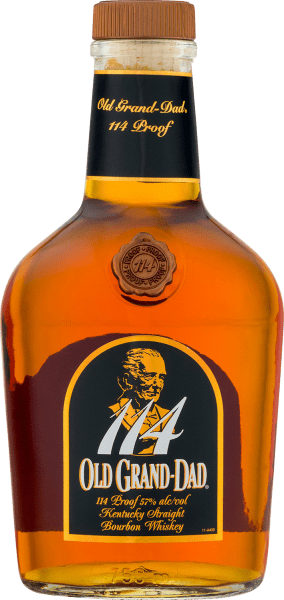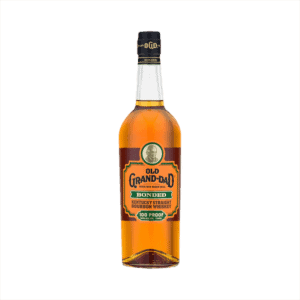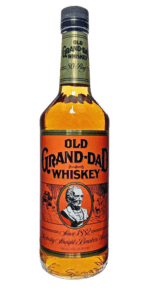Old Grand-Dad 114 is an underappreciated piece of bourbon history. Since we’ve already reviewed Old Grand-Dad and Old Grand-Dad Bonded, today it’s only fair to give Old Grand-Dad 114 the respect it deserves.
Old Grand-Dad 114-proof represents an underappreciated piece of bourbon history.
Although it is often left out of the broader bourbon discussion, it has its share of hardcore fans who seek out this low-volume brand. These whiskey fanatics understand its amazing value. It is the bourbon of choice among many old-school adherents to the pre-Prohibition, high-proof bourbon style of whiskey making nearly lost in the United States.
This ‘bottom-shelf bourbon’ brand has a long history that is incredibly interesting and a respected production approach that offers a robust rye pepper spice flavor profile. So grab a glass, and let’s learn more about this historic legacy brand — an offshoot bottle of bourbon that even well-versed geeks can be forgiven for not knowing.
History
This post is the third and final installment of our Old Grand-Dad trilogy.
In our review for Old Grand-Dad 80-proof, we attempted to establish the history of the Hayden family, including how third-generation Raymond B. Hayden created a brand to honor his distiller grandfather Meredith Basil Hayden.
The Hayden family were Kentucky frontier distillers. They established what would become a nationally recognized brand and are often given credit for solidifying a high-rye mashbill in bourbon making. The enduring appeal of the Old Grand-Dad brand has helped preserve this style of pre-Prohibition whiskey for today’s highly-educated bourbon drinkers to enjoy.
We also took a close look at the Bottled in Bond Act during our review of Old Grand-Dad Bonded. So today, let’s examine what happened after the Hayden family sold the distillery and brand to the Wathen family after Raymond Hayden died in 1888 with no heirs.
The Wathens were a historic bourbon family in their own right. When Prohibition put a halt on distillation and consumption of distilled spirits in the United States in 1920, the Wathens created the American Medicinal Spirits Company to take advantage of the many loopholes that evolved as the federal government took on the systematic dismantling of an entire centuries-old industry.
Similarities between the enforcement of the federal ban on alcohol and the United States’ War on Drugs’ campaign to end recreational use of banned substances like marijuana are unavoidable. One parallel included a prescription approach to whiskey that gave licenses to producers who made whiskey for patients that suffered from a list of ailments for which alcohol could be prescribed as medicine.
In this way, Old Grand-Dad was produced by the American Medicinal Spirits Company during Prohibition. AMS was created by the Wathen family as a way to take advantage of federal programs to consolidate the many barrels maturing in Kentucky into large government-administered warehouses. Old Grand-Dad was actually produced as an ‘American Bourbon-style’ product in Canada for a short period during the Prohibition years.
In 1929, AMS was acquired by the National Distillers Products Corporation, which was in turn acquired by Jim Beam in 1987. The bottles produced during the NDP years — 1929 to 1987 — has given Old Grand-Dad 114-proof a bit of a cult status among hardcore bourbon aficionados and collectors.
Bottles of Old Grand-Dad 114 produced during the NDP years have become sought after by bourbon hunters. Called ‘dusters,’ old collectible bottles like these pre-1987 bottles have collected considerable value at auction. You will know if you see it by the old-school label, which does not show an image of the bust of Basil Hayden like today’s version does.
After 1987, Old Grand-Dad was made by Jim Beam Brands — now part of Beam Suntory. But unlike other legacy brands like Old Crow and Old Overholt, Old Grand-Dad has retained its historical mash bill, making Old Grand-Dad and Basil Hayden unique among the Beam Suntory portfolio of Kentucky Straight Bourbon whiskeys.
Today, Old Grand-Dad is considered a standard-tier bourbon in terms of price range and — at 114-proof — an incredible value for those looking to dip their toes into the ‘barrel proof’ bourbon set.
Rumors began circulating in 2016 that the 114-proof expression would be discontinued among barrel stock inventory shortages due to the boom in interest and demand in the bourbon category. But so far, the brand expression has remained. However, it is a low-volume product compared to stablemates Old Grand-Dad 80-proof and Old Grand-Dad Bonded. So, finding the product in your local market may be difficult.
Mashbill
We have brushed on this topic in the past posts listed above, but the most fascinating feature of Old Grand-Dad’s mash bill — or list of grain ingredients — is its high-rye content. Old Grand-Dad bourbons utilize a mash bill of 63 percent corn, 27 percent rye and 10 percent malted barley.
This mash bill is unique among Beam Suntory’s lineup of bourbon brands. Only Old Grand-Dad and the sister brand with the same namesake, Basil Hayden’s Bourbon, use it. Nearly all of the other major Kentucky Straight Bourbon Whiskey brands produced by Beam Suntory use the Jim Beam mash bill: 5 percent corn, 13 percent rye and 12 percent malted barley.
The additional rye content gives Old Grand-Dad its distinctive rye spice flavor, often described as ‘rye spice’ or ‘black pepper’ in the finished product.
Distillation // Production // Maturation
While we’re discussing the nuances of column distillation, let’s mention a subtle claim mentioned in some marketing materials for the Old Grand-Dad 114-proof expression — namely, that it is pulled off the still at a lower 127-proof.
How do they do that?
A modern column still consists of a large cylinder with plates running across the diameter at regular intervals. By using this system the master distiller can continuously pump terminal beer into one end of the system and collect newmake or white dog spirit from the other.
As alcohol vapors move up the trays, it re-condenses in the higher trays while water and other non-alcoholic liquids fall downwards. Each tray essentially performs a re-distillation into more concentrated vapors. The vapors become stronger in alcohol percentage until, at the top, they can be pulled off above 190-proof — the threshold for vodka. Bourbon, on the other hand, cannot be distilled to above 160-proof by U.S. law.
Because each plate performs a type of distillation, the production team can precisely control the collection of the resulting spirit. In addition to getting stronger as the spirit moves upwards from tray to tray, it also has various levels of distillation byproducts — things like acetaldehydes in the heads and congeners and other compounds in the tails.
During a traditional final distillation on a copper pot still, volatile temperature alcohols come off first — at as high as 180-proof. Then, the heads cut is made, followed by a hearts collection of newmake that starts at roughly 165-proof off the still and continues until the flavors of the higher-temperature volatiles overwhelm the aroma and flavor of the ethyl alcohol — an art more than science that takes advantage of the distiller’s nose, tongue and sensory perceptions.
However, on a continuous column, the distiller can get a dialed-in distillate at a lower proof by pulling it from a lower tray. So, one fascinating consideration in an Old Grand-Dad 80 vs. Old Grand-Dad Bonded vs. Old Grand-Dad 114 matchup is the way the distillate is collected. For the production team to collect the distillate at the lower 127-proof, we can assume that the unaged ‘white dog’ spirit may have had what can be described as a ‘tailsy’ quality. While this can be pretty unpleasant off the still, an experienced distiller will tell you that the oily congeners that make it through during the low-end parts of the run near the tails cut can take on magical properties in the barrel.
As the spirit matures in new charred American oak, these compounds interact with the red layer of the wood. Chemical conversions take place that create compounds like vanillin, cinnamaldehyde, syringaldehyde and furfural that your taste buds perceive as vanilla, cinnamon, smokey and nutty flavors.
Because they are both trade-up opportunities for the bourbon enthusiast who already appreciates Old Grand-Dad 80-proof, it makes sense to consider an Old Grand-Dad Bonded vs. Old Grand-Dad 114 comparison here.
Old Grand-Dad 114 comes off the still at 127-proof, and Old Grand-Dad Bonded likely coming off at closer to 150-proof. But there are differences in maturation as well.
As a bonded bourbon, all of the barrels dumped for each batch of Old Grand-Dad Bonded must be distilled during the same year during one distillation season — either January through June or July through December. They must also be matured for at least four years.
Old Grand-Dad 114, in contrast, does not have an age statement. As a Kentucky Straight Bourbon Whiskey, it must be matured for a minimum of two years. Straight bourbons under four years are required to have an age statement. As a NAS – Non-Age Statement – whiskey, OGD-114 is almost certainly at least four years old. But by not carrying an age statement, the blending team has more leeway when selecting barrels to use for each batch’s composite blend.
All bourbons are required by law to be matured in new American charred oak barrels.
















